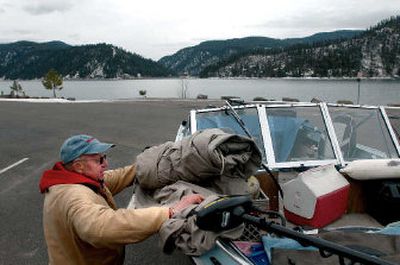Anglers question warning

Priest Lake is about as pristine as it gets. That’s why the recent government warning against eating too much fish from the lake raised the eyebrows of Coeur d’Alene fishing guide Jeff Smith.
“I was really surprised. It’s the cleanest, best water we have,” said Smith, an avid angler and owner of Fins and Feather Tackle Shop and Guide Service.
Similar warnings have been issued over the years for Lake Coeur d’Alene and Lake Pend Oreille, as well as the Spokane River and Lake Roosevelt in Washington. Smith said he can understand the presence of heavy metals in Lake Coeur d’Alene, which is filled by a watershed with a long history of mining. But Priest Lake?
“If you can’t eat the fish from there, you can’t eat them anywhere,” he said, adding that he is becoming “somewhat numb to all these studies.”
The state of Idaho is quick to point out the advisory is only for sensitive individuals – pregnant and nursing women or children under 7. And even for them the state allows for one meal of fish per week.
The mercury found in the flesh of Priest Lake’s lake trout likely comes from pollution caused by far-away coal-fired power plants, said Ned Horner, regional fisheries manager for the Idaho Fish and Game Department. It would be difficult to find any large water body free from mercury these days, Horner said.
“If they start to sample more areas, they’ll probably find it,” he said. “There are lots of countries that burn coal. It gets up in the atmosphere and travels the globe.”
This month’s mercury advisory was the first for Priest Lake simply because it was the first time anyone bothered to check the water. The test last spring was conducted by placing a lake trout in a blender, grinding the fish and measuring the amount of mercury found, said Chris Corwin of the state’s Department of Health and Welfare.
A typical kilogram of blended lake trout contained 0.22 milligrams of mercury, below the federal health advisory guideline of 0.3 milligrams but high enough to raise warning flags for vulnerable individuals.
Lake trout in neighboring Lake Pend Oreille average 0.42 milligrams of mercury per kilogram, or roughly twice the level of Priest Lake. Last year the state issued a warning for vulnerable individuals not to eat more than two meals a month of lake trout from Lake Pend Oreille. There are also advisories against eating too much fish from Lake Coeur d’Alene – not only from mercury, but because of lead, arsenic, zinc, selenium and other remnants from the region’s mines.
In Lake Roosevelt, no more than two meals a month of walleye are advised for young children and women of child-bearing age.
Mercury is a neurotoxin that can affect the brain, spinal cord and kidneys. According to the federal Centers for Disease Control and Prevention, one in 10 women is suspected of having enough mercury in her system to pose a threat of neurological damage to a fetus.
Lake trout in particular seem to carry high levels of mercury, as do other predatory species, including walleye, pike and bass. That’s because the fish live a long time, occupy top slots in the food chain and accumulate mercury from the smaller fish they feed on, Horner said. Other fish species contain less mercury, including perch and cutthroat and rainbow trout. These fish eat more insects, which contain less of the heavy metal.
Although the mercury level is relatively low in Priest Lake, Horner said its presence proves that no place seems to be safe from pollution.
“It’s just a wake-up call that we’re affecting our whole world with the things we do,” he said.
Idaho hopes to conduct more sampling in coming years, including follow-up tests on regional lakes, but there is no dedicated funding for the program, said Corwin, with the state’s Department of Health and Welfare. “It’s just being done by voluntary efforts.”
Most other states, including Washington, have extensive testing programs. Washington also carries some of the strictest warnings in the nation. Women of childbearing age and children under 6 are warned by state health officials against eating shark, swordfish, tilefish, king mackerel or tuna steak. No consumption is recommended for any fish caught in the Spokane River from Upriver Dam to the Idaho border – a stretch of water for which catch-and-release fishing is the law.
Smith, the fishing guide from Coeur d’Alene, said the information seems to change so fast that he’s not sure what to believe anymore. One week the government stresses the health benefits of eating fish, the next week there’s news the fish are dangerous. The standards are also different between states.
Most anglers seem to pay little heed to the advisories, Smith said.
“Most of these guys have heard so many studies, so many different things, we just don’t pay much attention to it,” he said.
Smith eats wild fish about twice a month. He favors the white filets of crappie, perch and walleye. But he also enjoys eating the rich, red flesh of Priest Lake lake trout.
“Personally, I don’t worry about it,” he said. Besides, “We’re not going to quit fishing.”